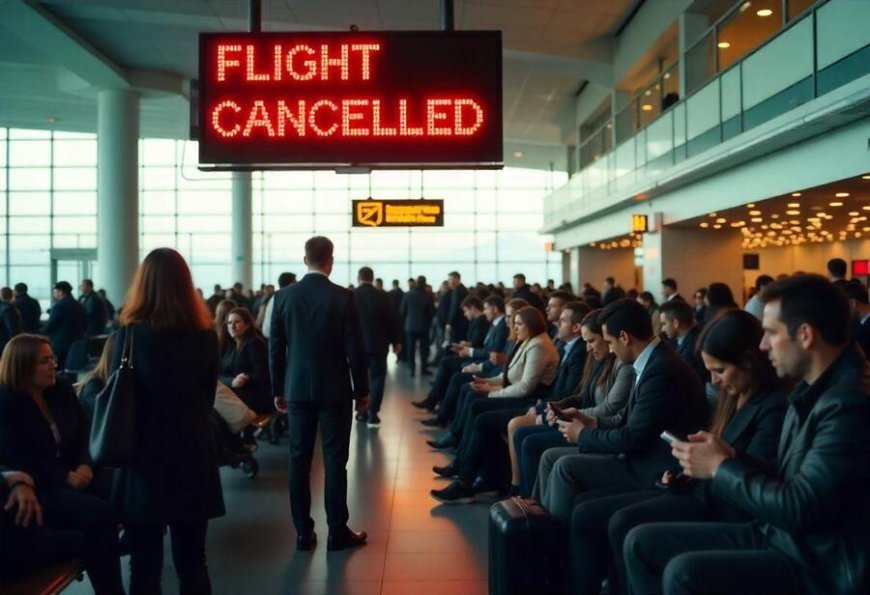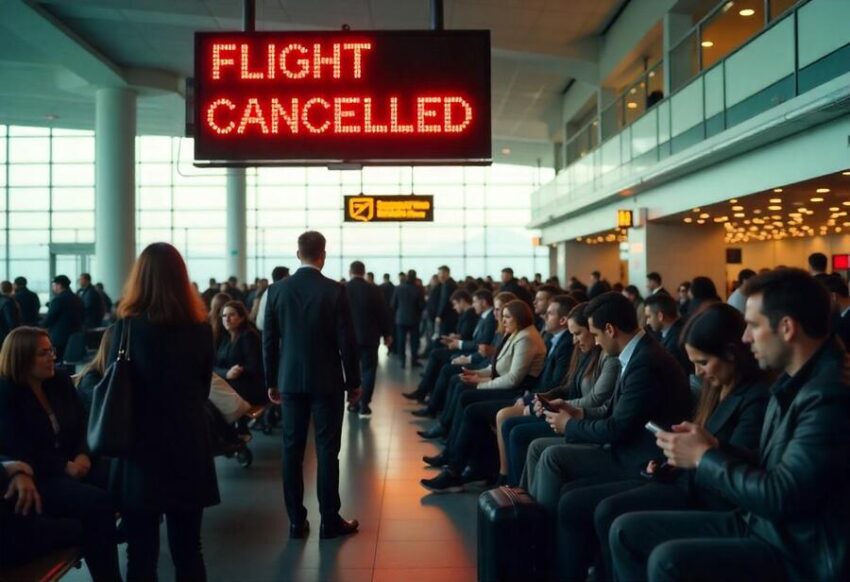Around 60 Flights Cancelled Across Asia, With Major Travel Disruptions at Shanghai, Shenzhen, and Tokyo Airports, Impacting Airlines Like China Eastern, Air Japan, Emirates, United, Air Canada, Korean Air and More


Around 60 flights have been cancelled across Asia today due to severe operational disruptions, affecting major airports in Shanghai, Shenzhen, and Tokyo, along with several leading airlines like China Eastern, Air New Zealand, Air Japan, Emirates, United, Air Canada, Korean Air and More. Delays and cancellations are primarily due to the concurrence of high passenger traffic, weather, and long-standing logistical concerns at these leading hubs. The ripple effect of such disruptions is extensive, leading to widespread delays in travel, rebooking, and increased pressure on airport operations, particularly during peak travel periods.
Today, several major airports across Asia are experiencing significant disruptions. Shenzhen Bao’an International has seen 703 delays and 26 cancellations (3.6% cancellation rate), with China Eastern Airlines and China Southern Airlines the most affected. At Shanghai Hongqiao, there have been 360 delays and 27 cancellations (7.0% cancellation rate), impacting China Eastern and Spring Airlines. Indira Gandhi International in India reports 82 delays and 4 cancellations (4.7% cancellation rate), mainly from SpiceJet and Air India. Soekarno-Hatta International in Jakarta has faced 339 delays and 7 cancellations (2.0% cancellation rate), with Batik Air and Garuda Indonesia being hit hardest. Tokyo Haneda has experienced 240 delays but no cancellations, mostly involving ANA and Air Japan. Singapore Changi has reported 131 delays and 1 cancellation (0.8% cancellation rate), affecting Emirates and Singapore Airlines. Incheon International in South Korea has had 162 delays, with no cancellations, and Taiwan Taoyuan International saw 154 delays, but no cancellations. These disruptions have left travelers facing significant delays and rebooking challenges across the region.
The cancellations and delays, impacting a variety of airlines, have also raised concerns about the logistical challenges facing Asia’s aviation industry, which is still recovering from pandemic-era disruptions and the subsequent rush of travelers returning to the skies. Let’s break down the situation at several key airports across Asia.
Shenzhen Bao’an International Airport – A Hotspot for Cancellations and Delays
At Shenzhen Bao’an International, one of China’s busiest airports, a total of 703 delays and 26 cancellations have been reported today. Among the airlines hit hardest by these disruptions are China Eastern Airlines and China Southern Airlines, which together account for the bulk of the cancellations. China Eastern alone has had 8 cancellations and 47 delays, affecting numerous domestic and international flights.
Other carriers such as Air China, Hainan Airlines, and Spring Airlines are also reporting delays, though to a lesser extent. For example, Air China had 6 cancellations and 43 delays, while Spring Airlines saw 2 cancellations and 15 delays.
These cancellations have created a ripple effect, with passengers experiencing significant inconvenience as they scramble to find alternate flights and rebook their trips. The airport’s operations team is reportedly working tirelessly to minimize the impact of these disruptions, but with such a large number of affected flights, the delays continue to mount.
Shanghai Hongqiao International Airport – Another Major Airport in Crisis
At Shanghai Hongqiao International, the situation is similarly chaotic, with a total of 360 delays and 27 cancellations recorded. Among the most affected airlines is China Eastern Airlines, which has seen 11 cancellations and 152 delays. Additionally, Spring Airlines, Shanghai Airlines, and China Southern Airlines have also faced substantial disruptions.
Airlines like United Airlines, Air Canada, and Korean Air are contributing to the overall disruptions, although to a lesser degree. United Airlines has experienced significant delays, while Air Canada has reported both delays and cancellations, further adding to the turmoil.
In addition to the large number of delays and cancellations, the situation at Shanghai’s Hongqiao airport has been compounded by a sudden surge in passenger traffic, with many travelers caught in the web of cancelled flights trying to secure rebooking options for the next available flight.
Indira Gandhi International Airport – Moderate Disruptions in India
Indira Gandhi International Airport in New Delhi, India, has seen 82 delays and 4 cancellations today. The bulk of the cancellations have been attributed to SpiceJet, which had 4 cancellations and 13 delays. Other airlines such as Air India, Air India Express, and Akasa Air have also reported delays, although cancellations remain relatively low in comparison to other airports across the region.
Despite the moderate number of cancellations, the delays are causing significant frustration for passengers, many of whom are struggling to rebook their flights, particularly as high travel demand continues to cause further congestion at India’s busiest airport.
Jakarta-Soekarno-Hatta International Airport – A Challenging Day for Indonesian Travelers
In Indonesia, Soekarno-Hatta International Airport in Jakarta has also experienced significant disruptions, with a total of 339 delays and 7 cancellations. Batik Air and Garuda Indonesia were the most affected, with Batik Air experiencing 5 cancellations and 69 delays, while Garuda Indonesia reported 2 cancellations and 72 delays.
Other airlines such as Lion Air, AirAsia, Citilink, and Malaysia Airlines have also seen a substantial number of delays, further complicating the travel situation at Indonesia’s busiest airport. Passengers flying out of Jakarta are facing considerable delays, with many being advised to contact their airlines for the latest flight status updates.
Tokyo International (Haneda) – Minimal Cancellations but Significant Delays
Tokyo International Airport (Haneda), one of the world’s busiest and most efficient airports, has experienced 240 delays but no cancellations today. All Nippon Airways (ANA) has been the hardest hit, with 80 delayed flights, followed by Air Japan and China Eastern Airlines, both of which have experienced several delays. Although there were no cancellations at Haneda today, the high number of delayed flights has still caused frustration among passengers, particularly those with connecting flights.
Other airlines, such as Emirates, United Airlines, and Air China, have also contributed to the delays, further compounding the challenges faced by travelers at Tokyo’s major hub.
Singapore Changi Airport – A Slightly Better Situation, But Not Without Its Challenges
Singapore Changi Airport has reported 131 delays and 1 cancellation today. Although the number of cancellations is relatively low compared to other airports, Emirates and Singapore Airlines have been affected by delays. AirAsia has also reported a number of delayed flights, contributing to the overall disruptions at one of the world’s most popular international airports.
The single cancellation reported at Changi was by Jetstar, which faced operational challenges today. While the situation at Changi is not as severe as at other airports, passengers are still facing delays, and some are being rebooked onto later flights as the airport works to manage the congestion.
Incheon International Airport – Minimal Disruptions in South Korea
In South Korea, Incheon International Airport has reported 162 delays but no cancellations. Asiana Airlines has been the most affected, with 25 delays, followed by China Eastern, Cathay Pacific, and Shandong Airlines. Despite the delays, the airport has not experienced the level of disruption seen at airports in Japan, China, and Indonesia. However, passengers still face lengthy waits and long lines at check-in counters and security checkpoints.
Taiwan Taoyuan International Airport – Minor Disruptions in Taiwan
In Taiwan, Taiwan Taoyuan International Airport has reported 154 delays but no cancellations today. The delays have been mainly caused by China Airlines, Eva Air, and Cathay Pacific, with some disruption also reported by smaller carriers like Air Macau and XiamenAir. However, the situation at Taiwan Taoyuan is relatively mild compared to other major hubs in Asia.
The Ripple Effect Across Asia
As the day progresses, the ripple effects of the flight cancellations and delays continue to disrupt travel plans across Asia. Many passengers are struggling to find alternative flights, particularly as many airlines are experiencing high levels of demand due to the holiday season and the post-pandemic travel boom.
Airlines are working diligently to rebook passengers and minimize delays, but the challenges of managing such a high volume of cancellations and delays are proving difficult. The airports in Shanghai, Shenzhen, Jakarta, and Tokyo are particularly overwhelmed, with long lines forming at check-in counters and security checkpoints as passengers try to navigate the chaos.
The delays and cancellations today highlight the vulnerability of the global aviation industry to unexpected disruptions, as well as the ongoing recovery efforts in the wake of the COVID-19 pandemic. Despite the challenges, airports and airlines across Asia are committed to ensuring the safety and comfort of their passengers while working to resolve the disruptions as quickly as possible.
Airline Disruptions Across Asia
The widespread flight disruptions today have affected several major airlines across Asia, causing delays and cancellations that have left passengers stranded or scrambling for rebookings. Airlines from various countries are facing operational challenges, with the following carriers hit the hardest: China Eastern Airlines, Air New Zealand, Air Japan, Emirates, United Airlines, Air Canada, Korean Air, Air China, Singapore Airlines, Air India, AirAsia, Garuda Indonesia, SpiceJet, Hainan Airlines, Spring Airlines, China Southern Airlines, Shenzhen Airlines, Cathay Pacific, XiamenAir, and Jetstar have all faced challenges due to operational difficulties, weather conditions, and high passenger volumes. The most significant disruptions have been seen at Shenzhen Bao’an International, Shanghai Hongqiao, and Tokyo Haneda, where passengers have experienced both cancellations and extensive delays. The scale of these disruptions has left travelers scrambling to find alternative flights, as airlines work to accommodate rebookings and minimize the impact on their schedules.
These disruptions have caused ripple effects across multiple regions, with passengers facing delays at airports such as Shenzhen Bao’an, Shanghai Hongqiao, Tokyo Haneda, Singapore Changi, and Soekarno-Hatta. The scale of the disruptions underscores the ongoing challenges the aviation industry faces in maintaining smooth operations amid rising travel demand.
Around 60 flights have been cancelled across Asia, with major disruptions at Shanghai, Shenzhen, and Tokyo airports due to operational challenges, high passenger volumes, and adverse weather conditions. Airlines like China Eastern, Air New Zealand, and Emirates are facing significant delays as a result.
As travelers continue to face uncertainty and delays across Asia’s busiest airports, airlines and airport authorities are working around the clock to resolve the situation and ensure that passengers can get back to their destinations as soon as possible.
The post Around 60 Flights Cancelled Across Asia, With Major Travel Disruptions at Shanghai, Shenzhen, and Tokyo Airports, Impacting Airlines Like China Eastern, Air Japan, Emirates, United, Air Canada, Korean Air and More appeared first on Travel And Tour World.






